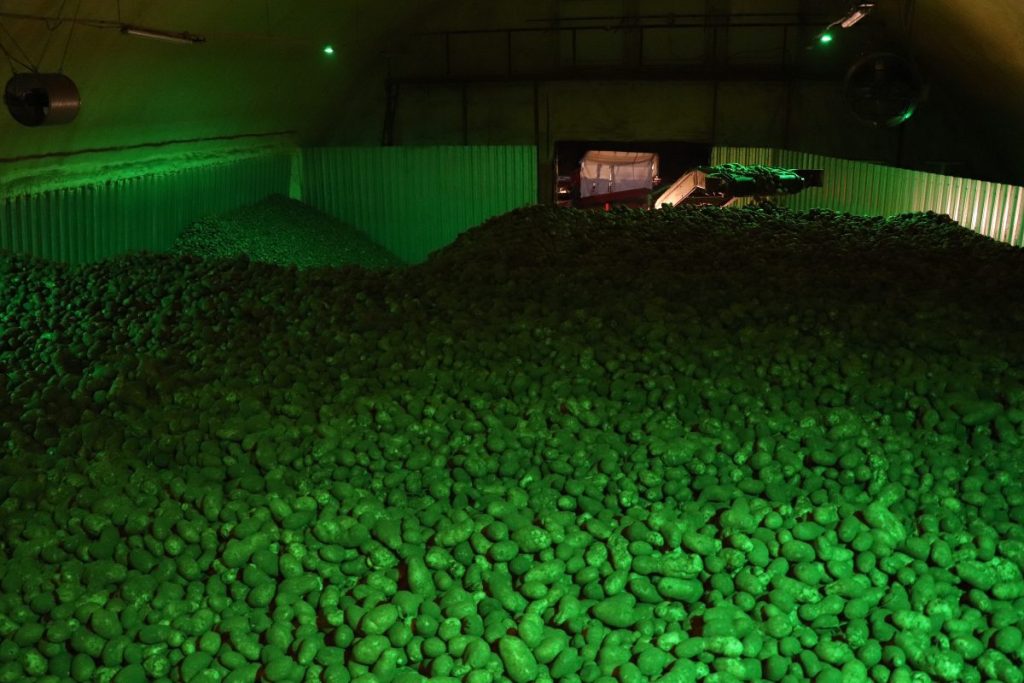University of Idaho – The potato industry has a term for the unpleasant surprise of cutting into a seemingly good potato to find a dark bruise inside.
Known as “cutting black,” the tuber quality issue is among the industry’s leading causes of lost revenue, especially in the fresh potato market. Pressure bruises affect anywhere from 10 to 20 percent of spuds coming out of storage.
However, researchers with University of Idaho and the U.S. Department of Agriculture’s Agricultural Research Service (USDA-ARS) believe they may be able to help. Gustavo Teixeira, a UI Extension potato postharvest physiologist; Nora Olsen, a UI Extension potato storage specialist; and Munevver Dogramaci, a research plant physiologist with USDA-ARS Northern Crop Science Laboratory in Fargo, N.D.; have launched a study testing three compounds for their potential to block bruised tissue from darkening.

Their work is funded with a $42,470 grant from the Northwest Potato Research Consortium. The products they’ll be evaluating are not currently labeled for use in potatoes in the U.S., but they hope their research will lead to more in-depth studies that justify moving forward with potato registrations.
“That is a huge potential for these products if we get good results,” Teixeira said.
U.S. potato farmers typically fill their storage cellars 18 feet deep with spuds. Potatoes are firm when they enter storage but lose water over time through respiration. After eight or nine months in storage, the weight of the pile can begin to flatten spuds near the bottom. Once those wounded potatoes are removed from storage and exposed to oxygen, bruises usually darken within four days, making the tubers unappealing to consumers.
On Sept. 19, the research team placed concrete blocks on piles of Russet Burbanks to simulate typical storage conditions. The spuds will be stored for eight months. Some of the spuds will be treated five days before coming out of storage with 1-Methylcoclopropene (1MCP), nitric oxide or diphenylamine (DPA) in gas form. A control group of potatoes exposed to pressure bruise using the concrete blocks will remain untreated, as will a control group that won’t be subjected to the simulated pile pressure.
“The goal of this project is not to control pressure bruise. It is to control the cutting black — the browning,” Teixeira said. “We are inducing the pressure bruise and at the end of storage after about eight months, we are going to apply products.”
DPA and 1MCP are both widely used in the U.S. apple and pear industries — DPA is applied to control browning resulting from a disorder known as superficial scald, and 1MCP helps extend the shelf life of the fruit. In Europe, 1MCP is also used to reduce potato shrinkage.
Bruises darken as part of the process plants use to heal wounds. The dark spots result from the oxidation of chemicals plants produce for their own protection, known as phenolics, to form natural pigments known as melanin. Teixeira and his team intend to apply 1MCP to block ethylene action in bruised spuds. When vegetables are damaged, ethylene is one of the first hormones they produce, and stimulating wound healing is one of the functions of ethylene.
- DPA is an antioxidant, which can prevent the initiation of browning by reacting with oxygen.
- Nitric oxide will be applied to block reactive oxygen species (ROS). ROS regulates signaling pathways, and the researchers hope to block the signal sent within a potato to stimulate bruises from darkening.

They’ll spend roughly three months evaluating data starting early in May 2024. If their tests produce encouraging results, they’ll likely test combinations of the compounds in a follow-up experiment.

